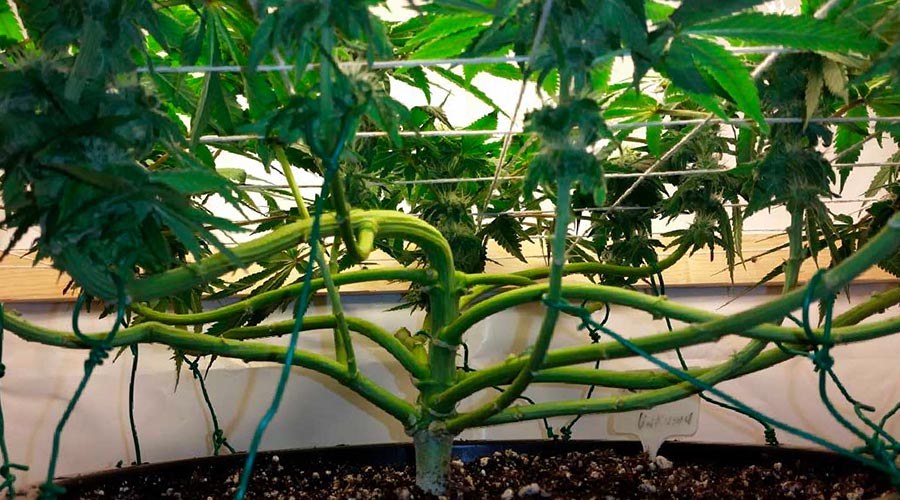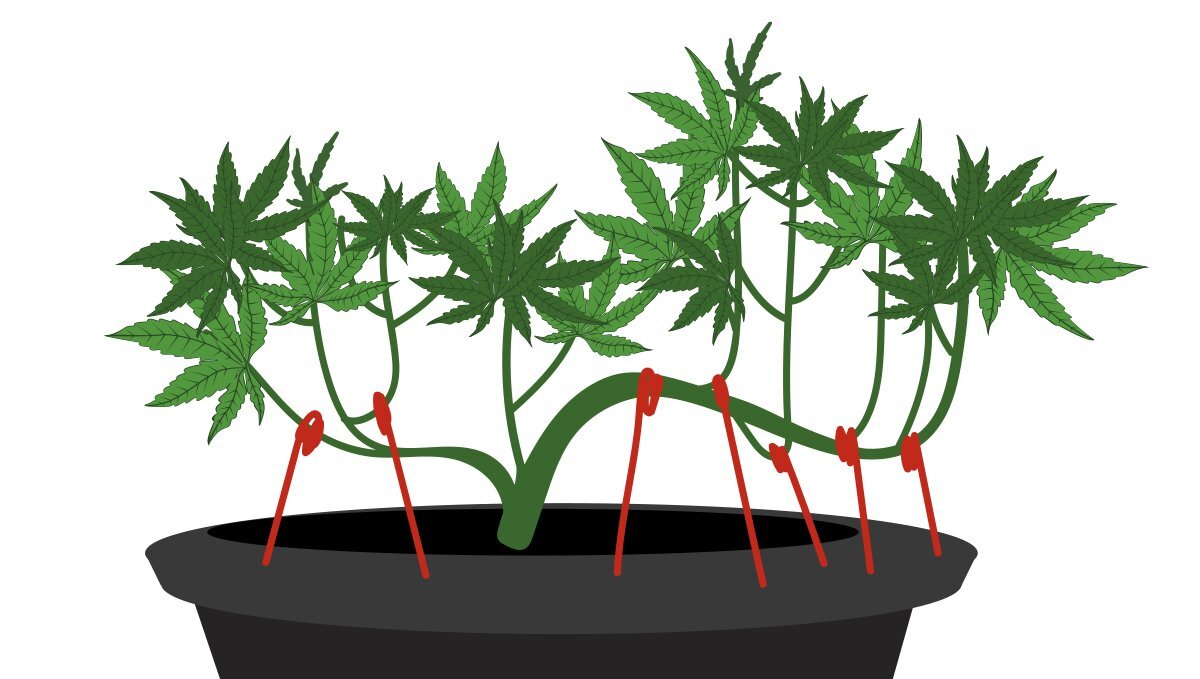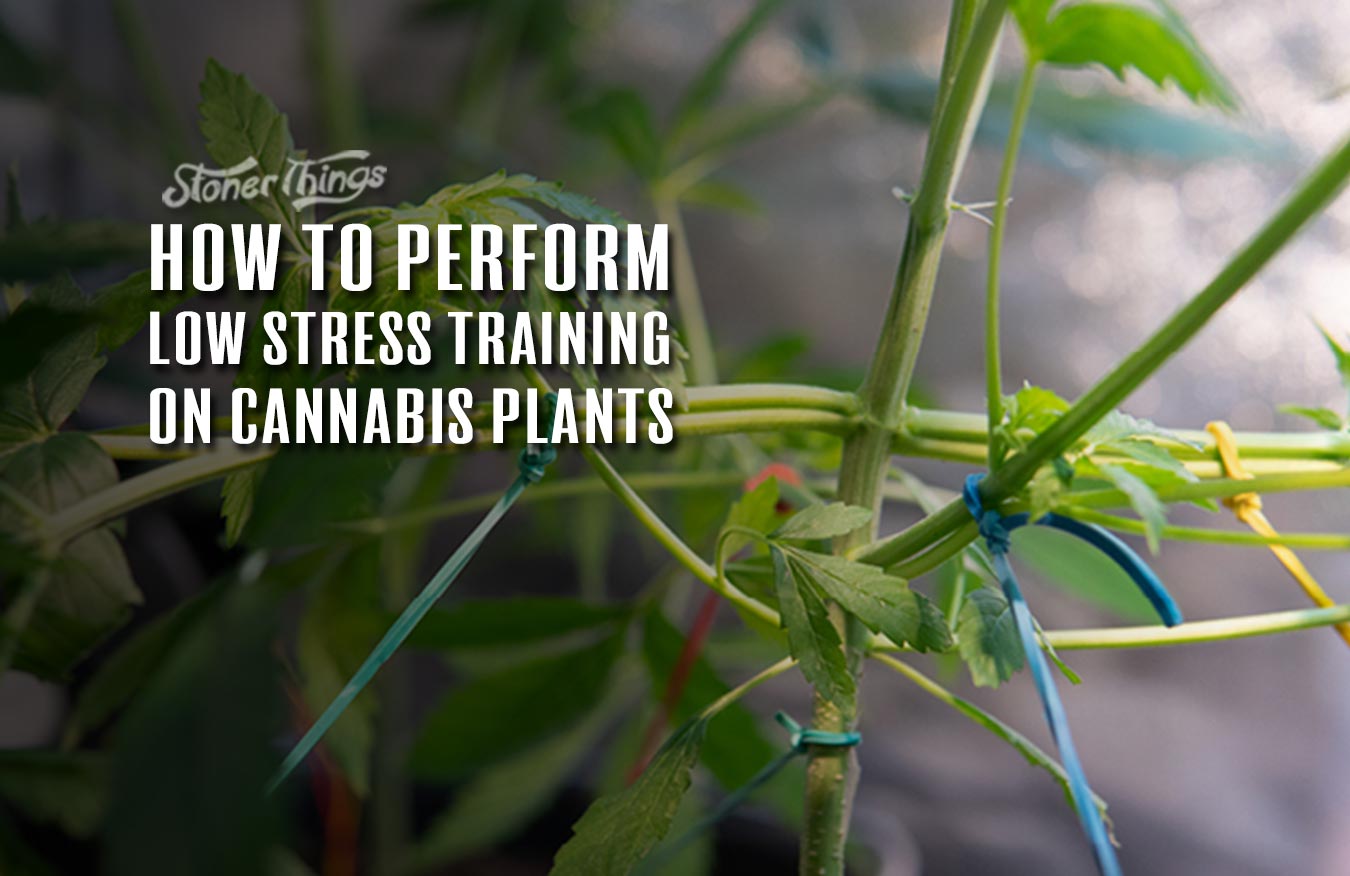If you’re getting into the world of home-grown cannabis, you’ll likely benefit from familiarizing yourself with low stress training. Low stress training can help preserve space and maximize yields in both indoor and outdoor grows. Best of all, it’s a great tool for beginners. Here’s everything you need to know.
What is low stress training (LST)?
Low stress training (LST) is a tactic used by growers to control the way cannabis plants grow in order to maximize yields and preserve space and accessibility for cannabis plants grown indoors and outdoors. By manipulating the growth patterns of cannabis plants, cultivators can get the most out of their available space and lighting.
Cannabis plants grow in what’s known as an apical dominance formation. This means that the plant is broad and bushy on the bottom and narrows towards the top, producing one single cola at the top and much smaller flowers on lower branches. Low stress training makes it possible to manipulate cannabis plants into producing multiple colas by growing outwards instead of upwards.


LST flattens cannabis plants into a canopy, which allows the plants to absorb more light and encourage multiple top colas and flower clusters. Essentially, low stress training involves bending and weaving stems through trellis netting or through the use of pipe cleaners to distribute the plant’s sugars and growth hormones more evenly throughout the plant. These hormones and sugars promote larger flowers, more apex colas, and higher yields. Bending the branches and stems is generally easy on the plant, so it tends to adapt quickly and not suffer from stress which can actually hurt yields.
Low stress training usually begins in the vegetative stage early on to train the plant stems and shoots while they’re still pliable and less prone to breaking. By bending branches and nodes to keep the plant growing outward instead of upward, the plant will begin to produce colas sprouting upwards even when the plant itself is growing sideways. However, low stress training can be practiced into the early weeks of the flowering stage and on autoflowering strains.
Low stress training: step by step guide
If you’re curious about how to incorporate low stress training into your garden, here’s a step-by-step breakdown of the process. You can start practicing LST when your plant’s stems and shoots are long enough to be tied down. You will need plant tape, pipe cleaners, rubber coated wire, or other soft materials to tie your plants down. Take care to avoid wire or string as they may cause damage to your stems as the plants grow.


1. Drill holes on your pots — You’ll need to drill several small holes around the rim of your pot. This is where you will anchor your branches and tie downs for the low stress training. You can also use a tomato ring, which you can use to comfortably weave larger branches as the plant grows.
2. Gently bend your main stems — Bend your stems very gently by pushing them back and forth until they become pliable. While you can fix broken branches with tape and let the plant heal, it causes them undue stress. By gently pushing your stems. you’ll only stress them out gently, which in the end will make them stronger. If you have four main branches, bend each one in an opposite direction so that each branch can grow and produce more branches in different directions that won’t compete with one another.
3. Secure your stems to the pot — Once your stems are bent, you can use a pipe cleaner to attach them to the pot. You don’t need to bring your branches all the way down to the rim of the pot, but bend them enough that they’re held taught under the pipe cleaner attached to the pot.
4. Defoliate your branches — Once your stems are tied down gently, you can defoliate your plants. Removing a few leaves can help maximize light penetration and expose future bud nodes to sunlight. Take care to not remove too many leaves, though. This can be detrimental to the plants’ ability to photosynthesize and hurt your yields.
5. Monitor your grow and continue training — LST is a lifelong process. New shoots will constantly appear, and they will also need to be bent and tied down. You should aim to adjust your bends periodically to keep your canopy even and encourage outward growth. You can continue low stress training through the entire veg cycle and for the first few weeks of flowering, though LST should be avoided for mature flowering plants. Too much stress or movement on the flowers can cause plants to hermaphrodite, or ruin your potency by damaging trichomes.
Screen of Green: LST alternative
If bending and manually tying your plants down sounds like a tedious process, you can always practice screen of green training. In this LST method, you’ll utilize a screen or trellis netting to encourage horizontal growth. In this method, branches that grow through the screen are simply bent and tucked back underneath the screen, inhibiting vertical growth.
Most growers utilize three tiers of trellis netting suspended over the plants. The first two are used for LST, by bending stems and keeping them suppressed under the trellis. The third screen is for supporting the massive colas that come from this method. Screen of green helps to improve yields and keep plants growing bushy instead of tall.
Low stress training: autoflower
Autoflowering plants grow super fast and will begin flowering without the standard light cycle change. High-stress training methods can harm autoflowering plants since they simply don’t have time to heal from the damage from the initial stress method. Autoflower strains benefit from low stress training greatly. Since autoflowering strains can begin flowering in as little as 2-4 weeks, low stress training should begin as soon as possible. To encourage better yields and an optimized growth pattern, LST can help autoflowering strains spread out an even canopy and produce bigger flowers.
Low stress training: Final thoughts
LST can be applied to all different types of cannabis strains, including autoflowering strains. This method is a great way to maximize yields and optimize light absorption rates, making for more potent cannabis. You can start low stress training in the veg cycle when the plant has established a few nodes and the stems are tall, pliable, and sturdy. Breaking a branch during low stress training isn’t going to be detrimental to your plants, either. You can use plant tape to graft the branch back on, and it will heal during its growth cycle. But with that said, try to be on top of training your plants throughout the veg cycle and even the early flowering stage to get the best possible results from your garden. Good luck!













